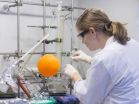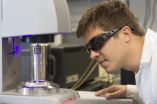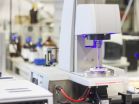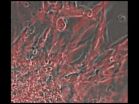(Press-News.org) In modern dentistry, amalgam fillings have become unpopular. Instead, white composite materials are more commonly used, which at first glance can hardly be distinguished from the tooth. The majority of these composites are based on photoactive materials that harden when they are exposed to light. But as the light does not penetrate very deeply into the material, the patients often have to endure a cumbersome procedure in which the fillings are applied and hardened in several steps. The Vienna University of Technology in collaboration with the company Ivoclar Vivadent have now developed a new generation of photoactive materials based on the element Germanium. Simply put, improved photoreactivity is good news for everyone who wants to spend as little time as possible in the dental chair.
Hardening With Light
Similar to natural tooth enamel, modern dental composites consist of a mixture of different material components. In addition to inorganic fillers they can also contain photoactive organic resins which react to light of a particular wavelength and readily solidify.
Professor Robert Liska and his team at the Vienna University of Technology (TU Vienna) have been working with such photoactive substances for a long time. Similar photoactive substances are used for additional applications including protective coatings and modern 3d-printing.
The penetration depth of the light depends on its wavelength. "Usually, light in the violet and ultraviolet region is used", says Robert Liska. It is also possible to use light with longer wavelengths, which penetrates deeper into the material, but then the polymerization process is less efficient. If the filling cannot be hardened in one step, the procedure has to be repeated several times. If the cavity is large, this can be rather uncomfortable.
Germanium-based Compound Initiates Chain Reaction
This problem can now be solved with a new Germanium-based molecule. It only makes up 0.04% of the composite material, but it plays a crucial role. The molecule is split into two parts by blue light, creating radicals, which initiate a chain reaction: molecular compounds, which are already present in the filling, assemble into polymers, and the material hardens.
The Germanium-based photo initiator was created at the Vienna University of Technology and then extensively tested by Ivoclar Vivadent. At Graz University of Technology, the physicochemical mechanism was investigated further. Using this new compound, the hardening depth could be increased from 2 mm to 4 mm, which considerably reduces the duration of the medical procedure.
Based on these excellent results, the Vienna University of Technology and Ivoclar Vivadent have made additional strides to further extend their collective research insterests in dental materials. Already in 2012, the Institute for Applied Synthetic Chemistry together with the Institute for Materials Science and Technology with collective funding from Ivoclar Vivadent and the Christian Doppler Research Association put into place a Laboratory for "Photopolymers in digital and restorative dentistry". Since its inception the laboratory has Goals for the laboratory include the development of improved photosensitive substances for dentistry with additional research efforts placed on 3D-printing of ceramic implants.
INFORMATION:
Additional Information:
Prof. Robert Liska
Institute of Applied Synthetic Chemistry
Vienna University of Technology
Getreidemarkt 9, 1060 Wien
T: +43-1-58801-163614
robert.liska@tuwien.ac.at
Faster dental treatment with new photoactive molecule
A new dental filling material, developed at the Vienna University of Technology, is easier to harden; It makes dental treatment faster and easier
2014-04-30
ELSE PRESS RELEASES FROM THIS DATE:
Entire star cluster thrown out of its galaxy
2014-04-30
The galaxy known as M87 has a fastball that would be the envy of any baseball pitcher. It has thrown an entire star cluster toward us at more than two million miles per hour. The newly discovered cluster, which astronomers named HVGC-1, is now on a fast journey to nowhere. Its fate: to drift through the void between the galaxies for all time.
"Astronomers have found runaway stars before, but this is the first time we've found a runaway star cluster," says Nelson Caldwell of the Harvard-Smithsonian Center for Astrophysics. Caldwell is lead author on the study, which will ...
Children's TV time is closely linked to parents' viewing habits
2014-04-30
The amount of time children spend in front of TV, phone and computer screens is closely associated with their parents' own habits, with much higher weekend viewing than during the week, a new study has found.
Researchers at the University of Bristol analysed the amount of time children aged five and six spent watching television, playing video games and using computers, tablets and smartphones – activities associated with a range of health problems, including obesity.
The study showed that 12 per cent of boys and eight per cent of girls in this age group watched more ...
Light activity every day keeps disability at bay
2014-04-30
CHICAGO --- Pushing a shopping cart or a vacuum doesn't take a lot of effort, but enough of this sort of light physical activity every day can help people with or at risk of knee arthritis avoid developing disabilities as they age, according to a new Northwestern Medicine® study.
It is known that the more time people spend in moderate or vigorous activities, the less likely they are to develop disability, but this is the first study to show that spending more time in light activities can help prevent disability, too.
"Our findings provide encouragement for adults who ...
Putting the endoparasitic plants Apodanthaceae on the map
2014-04-30
The Apodanthaceae are small parasitic plants living almost entirely inside other plants. They occur in Africa, Iran, Australia, and the New World. Bellot and Renner propose the first revision of the species relationships in the family based on combined molecular and anatomical data. They show that Apodanthaceae comprise 10 species, which are specialized to parasitize either legumes or species in the willow family.
Few plants are obligate parasites, and fewer still are endo-parasites, meaning they live entirely within their host, emerging only to flower and fruit. Naturally, ...
Coached extracurricular activities may help prevent pre-adolescent smoking and drinking
2014-04-30
Dartmouth researchers have found that tweens (preadolescents aged 10-14) who participate in a coached team sport a few times a week or more are less likely to try smoking. Their findings on the relationship between extracurricular activity and health risk behaviors are reported in "The relative roles of types of extracurricular activity on smoking and drinking initiation among tweens," which was recently published in Academic Pediatrics.
"How children spend their time matters," said lead author Anna M. Adachi-Mejia, PhD, a member of Norris Cotton Cancer Center's Cancer ...
Sell-side analysts lean towards high valuation companies for comparison
2014-04-30
Sell-side analysts lean towards high valuation companies for comparison, Rotman study shows.
Toronto – Brokerage-based analysts have a tendency to benchmark companies they are researching against others in the same category whose stock is already expensively-priced, shows a study from the University of Toronto's Rotman School of Management.
The result is that the company being researched may look undervalued and a good buy compared to the high valuation company. The finding provides some support for the idea that sell-side analysts choose "peer" companies strategically, ...
DNA repair gene provides new ideas for disease treatment
2014-04-30
A gene known to repair DNA damage in healthy cells may also provide new insights about treating a genetic disorder of the bone marrow, Caltech researchers say.
This finding was published in the May 15 print edition of the journal Cell Cycle.
In the study led by Judith Campbell, professor of chemistry and biology at Caltech, the researchers investigated the relationship between two genes—FANCD2 and DNA2—both known to play roles in fixing broken or damaged strands of DNA within a cell, called DNA repair. A defective version of the FANCD2 gene can result in the genetic ...
Watch out: Children more prone to looking but not seeing
2014-04-30
Children under 14 are more likely than adults to be 'blinded' to their surroundings when focusing on simple things, finds a new UCL study. It explains a somewhat frustrating experience familiar to many parents and carers: young children fail to notice their carer trying to get their attention because they have little capacity to spot things outside their area of focus.
The findings suggest that even something simple like looking at a loose thread on a jumper or an advert on the side of a bus might be enough to make children 'blind' to oncoming traffic and other dangers ...
Discovery of anti-appetite molecule released by fiber could help tackle obesity
2014-04-30
New research has helped unpick a long-standing mystery about how dietary fibre supresses appetite.
In a study led by Imperial College London and the Medical Research Council (MRC), an international team of researchers identified an anti-appetite molecule called acetate that is naturally released when we digest fibre in the gut. Once released, the acetate is transported to the brain where it produces a signal to tell us to stop eating.
The research, published in Nature Communications, confirms the natural benefits of increasing the amount of fibre in our diets to ...
Mouse study points to potentially powerful tool for treating damaged hearts
2014-04-30
VIDEO:
This shows heart tissue grown in a dish from mouse cardiac progenitor cells (CPCs). The CPCs, and the tissue they built, were engineered to produce a red protein.
Click here for more information.
A type of cell that builds mouse hearts can renew itself, Johns Hopkins researchers report. They say the discovery, which likely applies to such cells in humans as well, may pave the way to using them to repair hearts damaged by disease — or even grow new heart tissue for transplantation. ...
LAST 30 PRESS RELEASES:
First Editorial of 2026: Resisting AI slop
Joint ground- and space-based observations reveal Saturn-mass rogue planet
Inheritable genetic variant offers protection against blood cancer risk and progression
Pigs settled Pacific islands alongside early human voyagers
A Coral reef’s daily pulse reshapes microbes in surrounding waters
EAST Tokamak experiments exceed plasma density limit, offering new approach to fusion ignition
Groundbreaking discovery reveals Africa’s oldest cremation pyre and complex ritual practices
First breathing ‘lung-on-chip’ developed using genetically identical cells
How people moved pigs across the Pacific
Interaction of climate change and human activity and its impact on plant diversity in Qinghai-Tibet plateau
From addressing uncertainty to national strategy: an interpretation of Professor Lim Siong Guan’s views
Clinical trials on AI language model use in digestive healthcare
Scientists improve robotic visual–inertial trajectory localization accuracy using cross-modal interaction and selection techniques
Correlation between cancer cachexia and immune-related adverse events in HCC
Human adipose tissue: a new source for functional organoids
Metro lines double as freight highways during off-peak hours, Beijing study shows
Biomedical functions and applications of nanomaterials in tumor diagnosis and treatment: perspectives from ophthalmic oncology
3D imaging unveils how passivation improves perovskite solar cell performance
Enriching framework Al sites in 8-membered rings of Cu-SSZ-39 zeolite to enhance low-temperature ammonia selective catalytic reduction performance
AI-powered RNA drug development: a new frontier in therapeutics
Decoupling the HOR enhancement on PtRu: Dynamically matching interfacial water to reaction coordinates
Sulfur isn’t poisonous when it synergistically acts with phosphine in olefins hydroformylation
URI researchers uncover molecular mechanisms behind speciation in corals
Chitin based carbon aerogel offers a cleaner way to store thermal energy
Tracing hidden sources of nitrate pollution in rapidly changing rural urban landscapes
Viruses on plastic pollution may quietly accelerate the spread of antibiotic resistance
Three UH Rainbow Babies & Children’s faculty elected to prestigious American Pediatric Society
Tunnel resilience models unveiled to aid post-earthquake recovery
Satellite communication systems: the future of 5G/6G connectivity
Space computing power networks: a new frontier for satellite technologies
[Press-News.org] Faster dental treatment with new photoactive moleculeA new dental filling material, developed at the Vienna University of Technology, is easier to harden; It makes dental treatment faster and easier






